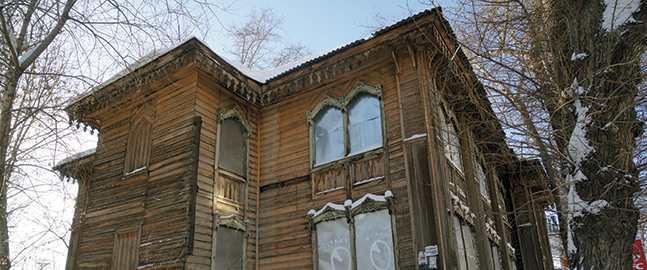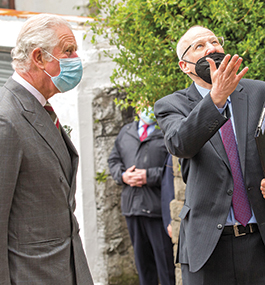Rescuing the Past
As it works to restore crumbling synagogues, the Foundation for Jewish Heritage promotes tolerance and understanding around the world.

Courtesy Foundation for Jewish Heritage
The Soldiers’ Synagogue
by Lawrence Goodman
Before World War II, Europe was home to some 17,000 synagogues, a rich tapestry of architectural styles, sizes, and eras. Only about 3,300 of those synagogues remain, many falling apart and decaying.
“We have to save these buildings,” says Michael Mail, GSAS MJC’83. “They are often the last testament to the Jewish life that was in these places.”
Mail launched the London-based Foundation for Jewish Heritage in 2015 to preserve Europe’s synagogues as well as other Jewish architectural sites at risk around the world. The foundation has mapped Europe’s remaining places of Jewish worship, identifying those that have the most historical significance and are at the greatest risk of destruction. It has also cataloged Jewish heritage sites in Iraq and Syria, and is part of a consortium working on a European Union-funded project to preserve more than 1,700 Jewish burial sites in Central and Eastern Europe, hundreds of which could disappear.
British historians Simon Schama and Simon Sebag Montefiore are among the foundation’s trustees. “Downton Abbey” creator Julian Fellowes, architect Daniel Libeskind, journalist Anne Applebaum, and poet Rita Dove are supporters.
In many cases, Jews no longer live alongside the synagogues, cemeteries, and other Jewish historical structures at risk of perishing. In these situations, Mail says, the foundation engages with and helps mobilize local communities in the preservation effort.
“The driving purpose of saving these buildings is to serve educational purposes,” he says. “These buildings can be vehicles for educating the Jewish people about their story and local populations about who the Jews were, combating ignorance and prejudice, and building empathy and understanding.”
Here are a few of the remarkable buildings the foundation is racing to save from destruction.
The Soldiers’ Synagogue (1907)
In 1827, Czar Nicholas I of Russia issued the Statute on Conscription Duty, requiring Russian Jews to serve in the army for 25 years. Eligibility started at age 12. Until the conscripts turned 18, they trained at military boardinghouses known as cantons, where they were pressured and sometimes tortured into converting to Christianity.
To escape conscription, some Jews fled the country or went into hiding. Some Jewish parents reportedly maimed their children so they wouldn’t be drafted.
It fell to the kahals, Jewish community councils, to identify recruits. When they couldn’t meet the Russian government’s quotas, which quadrupled for Jews in the late 1840s and 1850s due to the Crimean War, they enlisted kidnappers, many of them Jewish, to abduct Jews for service.
In 1856, reforms were implemented, and the quotas were reduced. By then, approximately 75,000 Jews had been drafted into the military. Many never saw their homes again.
A few Jews managed to thrive in the army and maintain their religious identity. Herzel Yankel Tsam rose to an officer’s rank in the army, a rare feat for a Jew in the 19th-century Russian military, especially one who hadn’t converted. He served in the Siberian town Tomsk, where, along with a group of other Jewish former soldiers, he built a house of worship that became known as the Soldiers’ Synagogue.
The building is one of the last remaining wooden synagogues in the world. It has three domes, neo-Moorish flourishes, and an exterior door shaped like a Torah scroll. During the years of the Soviet Union, it was confiscated and allowed to fall into disrepair. Many of its windows are boarded up, and its floor is falling apart.
Now reclaimed from the local municipality, the building is in the early stages of renovation, with financial assistance provided by the Foundation for Jewish Heritage. In the long term, the plan is to create a Jewish museum within the building while also restoring it as a house of worship for Tomsk’s small Jewish community.
Meir Tweig (1942)
In 1950, Baghdad was home to 60 synagogues. Today, it’s believed that only five Jews live in Iraq, not even enough for a minyan, the quorum of 10 required for public worship under Jewish law.
Though its paint is peeling, its brick facade is cracking, and its door is padlocked, Meir Tweig still stands, the only synagogue remaining in the Iraqi capital.
Jews arrived in Iraq more than 2,500 years ago, exiled there after the Babylonian king Nebuchadnezzar II ransacked Jerusalem and destroyed the First Temple. The Babylonian Talmud, a series of rabbinical commentaries and foundational texts on Judaism, was compiled in Iraq from 200-500 CE. Throughout Islam’s rise and spread, the Mongol conquests, and the Ottoman Empire’s reign, Jews built thriving communities in Iraq, made major contributions to the arts and sciences, and occupied the highest positions in society and government.
In 1941, disaster struck with the violent riots against Jews known as the Farhud (“destruction of order” in Arabic), killing more than 150 Jews and injuring hundreds of others. It was the culmination of years of rising pro-Nazi and antisemitic sentiment.
A year later, Meir Tweig was built. Yuval Evri, assistant professor of Near Eastern and Judaic studies, and the Marash and Ocuin Chair in Ottoman, Mizrahi, and Sephardic Jewish Studies, says although Iraqi Jews viewed the Farhud as a traumatic event, they nonetheless expected to remain in Iraq. He says they saw Baghdad, where Jews made up the largest minority, as “in many ways a Jewish city.”
But with Israel’s founding in 1948 and Iraq’s participation in the Arab-Israeli war, “it became unbearable to live in that kind of environment,” Evri says. By 1951, the Jewish population in Iraq had dropped from 150,000 to fewer than 10,000. The Jews who left forfeited all their property and revoked any claim to citizenship.
In a 2020 report, the Foundation for Jewish Heritage identified Meir Tweig as a top Jewish site in Iraq and Syria needing stabilization work. Not much can be done now, however, given Iraq’s volatile political situation and the risk of antisemitic violence. “Discreet conversations are going on, so it is not being ignored,” Mail says. “But there’s a general view that we’re waiting for better times before taking action.”
If there’s any hope, Evri says, it lies with younger generations of Iraqis, who want their country to become a more tolerant and diverse society. These Iraqis, Evri says, want to preserve Jewish historical sites as symbols of their country’s multicultural past.
Orla Synagogue (late 17th century)
When the Orla Synagogue was built, a Hebrew inscription over the entrance read, “How awesome is this place! This is none other than the house of God.”
Today, a fading sign inside the synagogue reminds visitors not to urinate on the walls.
Jews began settling in Orla, a village in northeast Poland, in the early 17th century, after Polish-Lithuanian prince Krzysztof Radziwill II allowed for the settlement of “folk of all sort, both Christians of all confession and Jews as traders, craftsmen, merchants, innkeepers.” According to legend, the Jewish villagers were told they could buy the local church if they could gather 10,000 groschen (silver coins) in a night; the villagers raised the money in an hour.
More likely, the brick synagogue was built over many years atop an existing wooden one. The new structure was more ornate, with colorful frescoes of plants and animals, a magnificent Torah ark, and a vaulted interior built in a mix of Baroque and Renaissance styles. “The community poured their heart and soul into that building,” Mail says. Jews dominated the crafts in Orla for the next 200 years, working as tailors, shoemakers, furriers, bakers, butchers, and tanners. In 1938, a massive fire burned much of the village. Though damaged, the synagogue survived.

Courtesy Foundation for Jewish Heritage
Michael Mail, GSAS MJC’83 (right), shows King Charles III (then Prince of Wales) around a historic synagogue in Merthyr Tydfil, Wales, in 2021.
page 2 of 2
Four years later, the Nazis sent most of the town’s 1,500 Jews to their deaths at the Treblinka extermination camp. German officials stored the furniture they took from the Jews in the synagogue and destroyed its Torah ark.
After World War II, the building fell into disrepair — at one point, it was used to store chemical fertilizers — and was then abandoned.
Today, local organizations are pursuing plans for preserving the synagogue. Last year, the Foundation for Jewish Heritage, inspired by the synagogue’s history and setting, held an arts festival in Orla, which sought to promote cross-cultural dialogue. The foundation hopes to establish a permanent arts program linked to a local arts college.
Híjar (early 15th century)
In 2017, preservationists were working on the Church of San Antón in Híjar, Spain, when they found a mural of a menorah that had been covered up by a rendering of a saint.
Additional work has exposed other Jewish murals; a few letters of a Hebrew inscription, possibly from the Book of Psalms; and the foundations of a tevah/bimah (synagogue platform). “The murals are totally unique,” says Mail. “We haven’t seen this work anywhere else.”
The Jewish community in Híjar dates back to the 13th century. At its height, approximately 30 households were concentrated in the area around the synagogue. The synagogue was built in the mudéjar style, a mix of Muslim and Christian influences typical of Spanish architecture at the time. The bimah was a square structure with a wooden floor, corner pillars, and two ladder-like wooden stairs that allowed access to the platform from the north and south.
By 1482, Eliezer ben Alantansi, whose father had been burned at the stake by inquisitors for being present at the circumcision of a Jewish convert to Christianity, had established a printing house in Híjar that produced Hebrew Bibles and Jewish legal works in Roman type. These are some of the earliest books printed in Hebrew — and some of the most beautiful ever produced.
With the expulsion of Jews from Spain in 1492, the flourishing Jewish life in Híjar came to a crashing and tragic end. The synagogue was taken over by the Catholic Church and dedicated to St. Anthony the Abbot, the Egyptian-born hermit credited with founding Christian monasticism. Over time, the building fell into disuse and disrepair. In 2010, part of its roof collapsed.
Jonathan Decter, the Edmond J. Safra Professor of Sephardic Studies, says only eight synagogues from medieval Iberia remain, out of the dozens, if not hundreds, that must have dotted the peninsula. A building in Girona, Spain, associated with the Jewish scholar and rabbi Nachmanides has long been thought to have been a synagogue, but doubts about the claim have recently arisen. This makes the survival of Híjar’s synagogue all the more remarkable, Decter says, since its uncovered murals are proof of its authenticity.
The Foundation for Jewish Heritage has been supporting plans developed by the Híjar mayor to turn the synagogue into a Sephardic Jewry heritage center, and the European Union recently provided funding to rehabilitate Híjar’s Jewish quarter.
